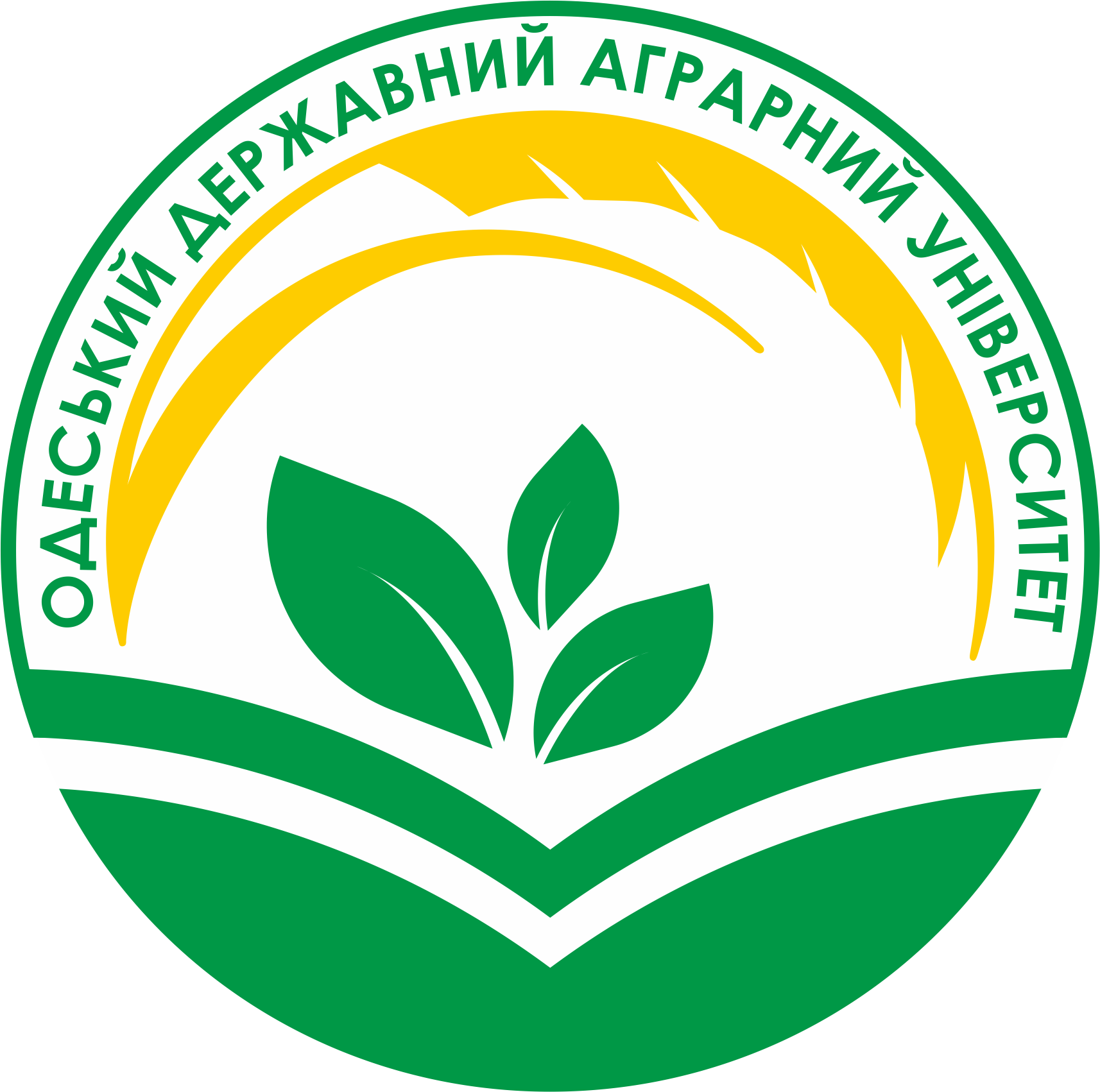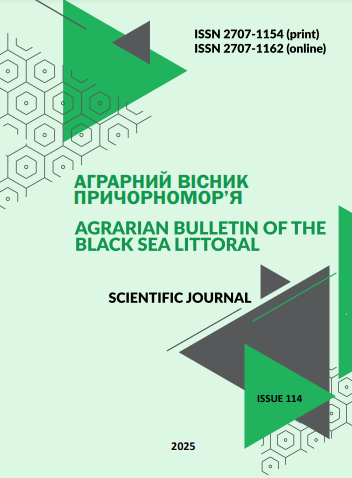ІННОВАЦІЇ В САНІТАРІЇ ТА ГІГІЄНІ В СКОТАРСТВІ
DOI:
https://doi.org/10.37000/abbsl.2025.114.05Ключові слова:
дезінфекція, метод, підготовка, концентрація, експозиція.Анотація
У статті представлено результати визначення ефективних схем та розробки методики застосування трьох дезінфекційних засобів, які в різних комбінаціях включають четвертинні амонієві сполуки, полігексаметиленгуанідину гідрохлорид, глутаровий альдегід та інші речовини. Дослідження проводились на виробничих потужностях Національного наукового центру «Інститут експериментальної та клінічної ветеринарної медицини» (м. Харків). Дезінфікуючі засоби були застосовані відповідно до чинних інструкцій та правил. Запропоновані методи дезінфекції відповідають сучасним вимогам біобезпеки та біозахисту у тваринництві. Вони зручні у використанні, екологічно безпечні, високоефективні та економічно вигідні. Результати цього дослідження надають цінні ресурси для планування та впровадження санітарно-гігієнічних заходів у тваринництві. Майбутні дослідження спрямовані на розробку всеосяжної, науково обґрунтованої системи санітарно-гігієнічних практик, спеціально розроблених для молочного тваринництва.
Посилання
Ahmed, W.I., Mohammed, A.N., & Sleim, AS.A. (2024). Efficacy evaluation of hydrogen peroxide disinfectant based zinc oxide nanoparticles against diarrhea causing Escherichia coli in ruminant animals and broiler chickens. Scientific Reports, 14, 9159 (2024). https://doi.org/10.1038/s41598-024-59280-4
Alarcon, P., Marco-Jimenez, F., Horigan, V., Ortiz-Pelaez, A., Rajanayagam, B., Dryden, A., Simmons, H., Konold, T., Marco, C., Charnley, J., Spiropoulos, J., Cassar, C., & Adkin, A. (2021). A review of cleaning and disinfection guidelines and recommendations following an outbreak of classical scrapie. Preventive Veterinary Medicine, 193, 105388. https://doi.org/10.1016/j.prevetmed.2021.105388
Aliiev, E., Paliy, A., Kis, V., Paliy, A., Petrov, R., Plyuta, L., Chekan, O., Musiienko, O., Ukhovskyi, V., & Korniienko, L. (2022). Establishment of the influence of technical and technological parameters of dairy and milking equipment on the efficiency of machining. Eastern-European Journal of Enterprise Technologies, 1(1(115)), 44–55. https://doi.org/ 10.15587/1729-4061.2022.251172
Allen, R., Boden, L.A., Hutchinson, I., Stirling, J., & Porphyre, T. (2024). Cleaning practices of transport vehicles by commercial and non-commercial livestock markets users in Scotland. Research in Veterinary Science, 180, 105413. https://doi.org/10.1016/j.rvsc.2024.105413
Hancox, L.R., Le Bon, M., Dodd, C.E., & Mellits, K.H. (2013). Inclusion of detergent in a cleaning regime and effect on microbial load in livestock housing. The Veterinary Record, 173(7), 167. https://doi.org/10.1136/vr.101392
Hasan, M.A., Miyaoka, Y., Kabir, M.H., Kadota, C., Hakim, H., Shoham, D., Murakami, H., & Takehara, K. (2022). Evaluation of virucidal quantitative carrier test towards bovine viruses for surface disinfectants while simulating practical usage on livestock farms. Microorganisms, 10(7), 1320. https://doi.org/10.3390/microorganisms10071320
Jiang, L., Li, M., Tang, J., Zhao, X., Zhang, J., Zhu, H., Yu, X., Li, Y., Feng, T., & Zhang, X. (2018). Effect of different disinfectants on bacterial aerosol diversity in poultry houses. Frontiers in Microbiology, 9, 2113. https://doi.org/10.3389/fmicb.2018.02113
Kamal, M.A., Khalaf, M.A., Ahmed, Z.A.M., & Jakee, J.E. (2019). Evaluation of the efficacy of commonly used disinfectants against isolated chlorine-resistant strains from drinking water used in Egyptian cattle farms. Veterinary World Journal, 12(12), 2025–2035. https://doi.org/10.14202/vetworld.2019.2025-2035
Kim, S., Chung, H., Lee, H., Myung, D., Choi, K., Kim, S., Htet, S.L., Jeong, W., & Choe, N. (2020). Evaluation of the disinfectant concentration used on livestock facilities in Korea during dual outbreak of foot and mouth disease and high pathogenic avian influenza. Journal of Veterinary Science, 21(3), e34. https://doi.org/10.4142/jvs.2020.21.e34
Maertens, H., Van Coillie, E., Millet, S. Van Weyenberg, S., Sleeckx, N., Meyer, E., Zoons, J., Dewulf, J., & De Reu, K. (2020). Repeated disinfectant use in broiler houses and pig nursery units does not affect disinfectant and antibiotic susceptibility in Escherichia coli field isolates. BMC Veterinary Research, 16, 140 (2020). https://doi.org/10.1186/s12917-020-02342-2
Matsuzaki, S., Azuma, K., Lin, X., Kuragano, M., Uwai, K., Yamanaka, S., & Tokuraku, K. (2021). Farm use of calcium hydroxide as an effective barrier against pathogens. Scientific Reports, 11(1), 7941. https://doi.org/10.1038/s41598-021-86796-w
Onodera, T., Sakudo, A., Sugiura, K., Haritani, M., Furusaki, K., & Kirisawa, R. (2023). Antiviral agents and disinfectants for foot-and-mouth disease (Review). Biomedical Reports, 19, 57. https://doi.org/10.3892/br.2023.1639
Paliy, A., Pavlichenko, O., Berezovskyi, A., Fotin, A., Kisil, D., & Panasenko, O. (2024). Bactericidal properties of inorganic acids against mycobacteria. Veterinarska Stanica, 55 (4), 375–386. https://doi.org/10.46419/vs.55.4.8
Paliy, A.P. (2018). Differential sensitivity of mycobacterium to chlorine disinfectants. Mikrobiolohichnyi Zhurnal, 80(2), 104–116.
https://doi.org/10.15407/microbiolj80.02.104
Rodionova, K., Paliy, A., & Кhimych, M. (2021). Veterinary and sanitary assessment and disinfection of refrigerator chambers of meat processing enterprises. Potravinarstvo Slovak Journal of Food Sciences, 15, 616–626. https://doi.org/10.5219/1628
Tarka, P., & Nitsch-Osuch, A. (2021). Evaluating the virucidal activity of disinfectants according to European Union standards. Viruses, 13(4), 534. https://doi.org/10.3390/v13040534
Weber, L., & Meemken, D. (2018). Hygienic measures during animal transport to abattoirs - a status quo analysis of the current cleaning and disinfection of animal transporters in Germany. Porcine Health Management, 4, 1. https://doi.org/10.1186/s40813-017-0078-x
Yakubchak, O.M., Khomenko, V.I., Midyk, S.V., Adamenko, L.V., Oliynyk, L.V., Yashchenko, O.F., Kovalenko, V.L., Sergienko, O.I., Kovalchyk, L.M., & Khom’yak, R.V. (2010). Veterinary disinfection, deodorization, disinsection, disinvasion, deratization. Instructions. – K.: Bioprom, 62 p.
Yu, D., Stothard, P., & Neumann, N.F. (2024). Emergence of potentially disinfection-resistant, naturalized Escherichia coli populations across food- and water-associated engineered environments. Scientific Reports, 14, 13478 (2024). https://doi.org/10.1038/s41598-024-64241-y
Zavgorodnii, A.I., Pozmogova, S.A., Kalashnyk, M.V., Paliy, A.P., Plyuta, L.V., & Palii, A.P. (2021). Etiological factors in triggering non-specific allergic reactions to tuberculin in cattle. Regulatory Mechanisms in Biosystems, 12(2), 228–233. https://doi.org/10.15421/022131
Zavhorodnii, A., Bilushko, V., Paliy, A., Kalashnyk, M., Kalashnyk, N., & Paliy, A. (2022). Freeze-Drying improved the stability of Tuberculin Purified Protein Derivative (PPD) in mammals. Problems of Cryobiology and Cryomedicine, 32(1), 63–67. https://doi.org/10.15407/cryo32.01.063
##submission.downloads##
Опубліковано
Як цитувати
Номер
Розділ
Ліцензія

Ця робота ліцензується відповідно до Creative Commons Attribution-NonCommercial 4.0 International License.


